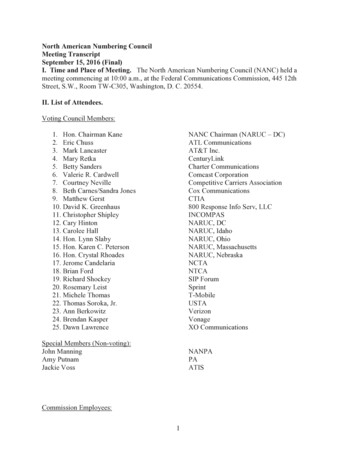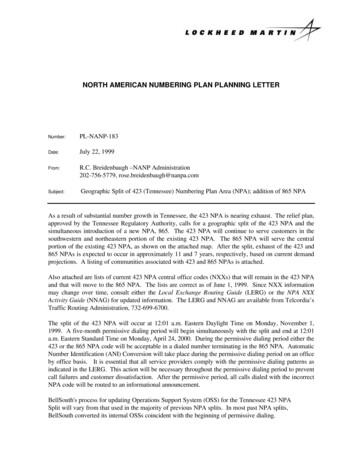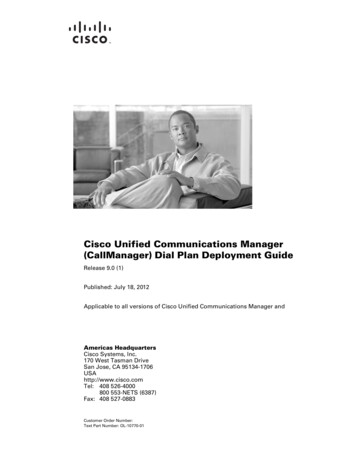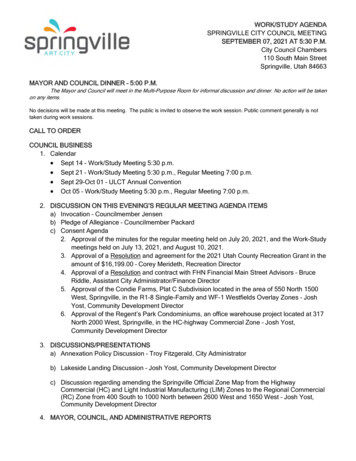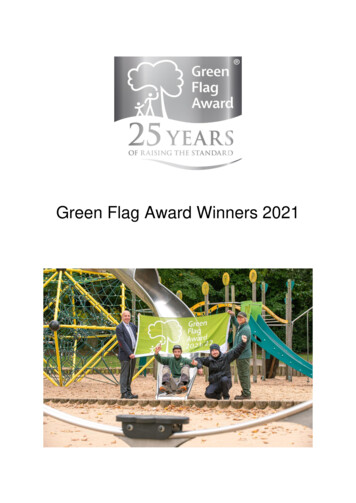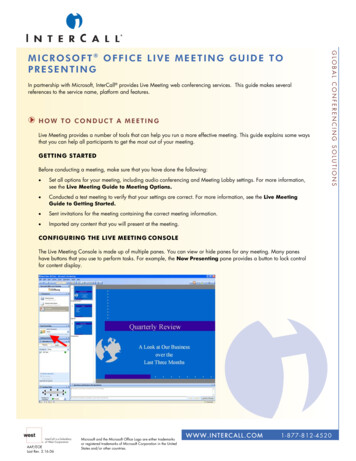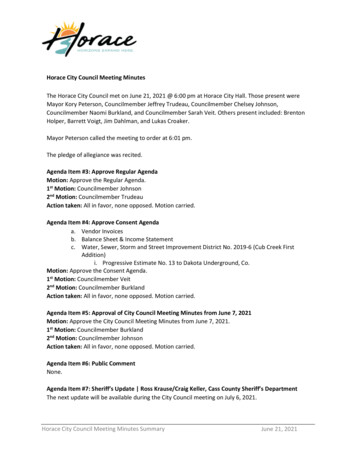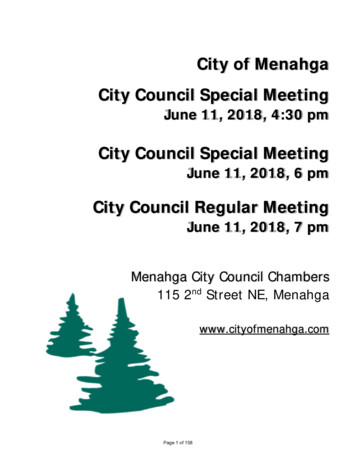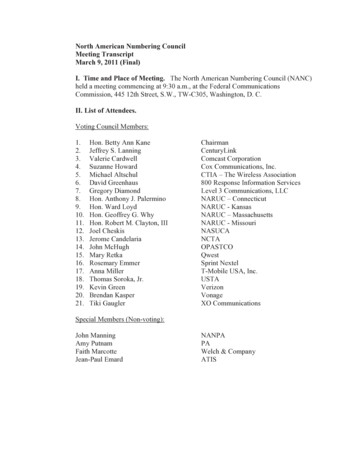
Transcription
North American Numbering CouncilMeeting TranscriptMarch 9, 2011 (Final)I. Time and Place of Meeting. The North American Numbering Council (NANC)held a meeting commencing at 9:30 a.m., at the Federal CommunicationsCommission, 445 12th Street, S.W., TW-C305, Washington, D. C.II. List of Attendees.Voting Council 18.19.20.21.Hon. Betty Ann KaneJeffrey S. LanningValerie CardwellSuzanne HowardMichael AltschulDavid GreenhausGregory DiamondHon. Anthony J. PalerminoHon. Ward LoydHon. Geoffrey G. WhyHon. Robert M. Clayton, IIIJoel CheskisJerome CandelariaJohn McHughMary RetkaRosemary EmmerAnna MillerThomas Soroka, Jr.Kevin GreenBrendan KasperTiki GauglerChairmanCenturyLinkComcast CorporationCox Communications, Inc.CTIA – The Wireless Association800 Response Information ServicesLevel 3 Communications, LLCNARUC – ConnecticutNARUC - KansasNARUC – MassachusettsNARUC - MissouriNASUCANCTAOPASTCOQwestSprint NextelT-Mobile USA, Inc.USTAVerizonVonageXO CommunicationsSpecial Members (Non-voting):John ManningAmy PutnamFaith MarcotteJean-Paul EmardNANPAPAWelch & CompanyATIS
Commission Employees:Marilyn Jones, Designated Federal Officer (DFO)Deborah Blue, Special Assistant to the DFOAnn Stevens, Deputy Chief, Competition Policy DivisionSanford Williams, Competition Policy DivisionGary Remondino, Competition Policy DivisionIII. Estimate of Public Attendance. Approximately 30 members of the publicattended the meeting as observers.IV. Documents (12)AgendaNANC Meeting Transcript – December 16, 2010North American Numbering Plan Administration (NANPA) Report to theNANCNational Thousands Block Pooling Administrator (PA) Report to the NANCNumbering Oversight Working Group (NOWG) ReportBilling and Collection Agent ReportBilling and Collection Working Group (B&C WG) Report to the NANCNANC/NAPM LLC Consensus Proposal for Clarification of the FCC’s RulesRegarding the LNPA Selection ProcessPetition of Telcordia Technologies, Inc. to Reform or Strike Amendment 70,to Institute Competitive Bidding for Number Portability Administration andto End the NAPM LLC’s Interim Role in Number Portability AdministrationContractNorth American Portability Management (NAPM) LLC Report to the NANCLocal Number Portability Administration Working Group (LNPA WG)Status Report to the NANCIndustry Numbering Committee (INC) Report to the NANCFuture of Numbering (FoN) Working Group Report to the NANCV. Table of Contents.1.Announcements and Recent News42. Approval of Meeting Transcript from December 16, 201025
3.Report of the North American Numbering Plan Administrator(NANPA)64.Report of the National Thousands Block Pooling Administrator (PA)135.Report of the Numbering Oversight Working Group (NOWG)216.Report from the North American Numbering Plan Billing andCollection (NANP B&C) Agent277.Report of the Billing and Collection Working Group (B&C WG)318.Update on Process for Selecting LNP Database, Platform andServices Provider(s)37North American Portability Management (NAPM) LLC Report469.10. Report of the Local Number Portability Administration WorkingGroup (LNPA WG)4711. Status of the Industry Numbering Committee (INC) activities6312. Report of the Future of Numbering Working Group (FoN WG)6813. Summary of Action Items--14. Public Comments and Participation (five minutes per speaker)--15. Other Business--VI.Summary of the Meeting.CHAIRMAN KANE:Good morning. I’m going to call to order theregular meeting of the North American Numbering Council. For the record it is 9:45a.m. on Wednesday, March 9, 2011, and we are meeting in the hearing room of theFederal Communications Commission at 445 12th Street, S.W., in Washington, D.C.I’m Betty Ann Kane, Chairman, for the record.3
There is a sign in sheet going around somewhere. Be sure to sign in so wehave the official record of everyone who’s here.A couple of housekeeping matters. Again to remind you, when you do go tospeak just give it a couple seconds pause so the gentleman who is controlling themicrophones back in the booth there can activate your microphone. You don’t needto push anything to put it on but if you start talking immediately we’re not going tocapture the first few golden words for the transcript.ANNOUNCEMENTS AND RECENT NEWSI have a couple of announcements. First of all we want to welcome, and Ithink he is on the phone, our newest member of the North American NumberingCouncil and that is Commissioner Ward Loyd from the Kansas CorporationCommission, Public Utility Commission. Commissioner Loyd, are you on thephone? Not yet. We do have a bridge.Commissioner Loyd is taking the place of our long time colleague Ann Boyleof the Nebraska Commission. Ann has moved on to the great Joint Board, the USFJoint Board and so she has resigned as a member of this Council. I want to thankAnn for all of her work.And in addition, thank Don Gray of the Nebraska staff who has been a verylong time alternate member and has participated actively, and has done terrific workalso with the Future of Numbering Committee. I think Don is going to be on thephone today as part of the report from the Future of Numbering Committee.So I want to thank Ann, and particularly Don for his work, and welcome4
Commissioner Loyd.I also want to welcome Valerie Cardwell, representing Comcast. Valerie isreplacing Cindy Sheehan from Comcast, so welcome.Are there any other new members, anyone who hasn’t been here before?Very good.And I want to thank the Bureau also for moving quickly in naming andapproving the recommendation from NARUC that Commissioner Loyd be the newmember. So it’s good to have as full a complement as we can.Okay, the first item on our agenda is the agenda and for the record that willbe document number one to put into the record.Are there any additions or rearrangements for the agenda that anyone has? Itwas sent out ahead of time. Okay, then we’ll accept that as the agenda for themeeting.APPROVAL OF MEETING TRANSCRIPTCHAIRMAN KANE: The next item which we’ll document number two forthe record is the approval of the transcript of our last meeting which was onDecember 16, 2010. Again, that was sent out electronically. Are there any additionsor corrections to the transcript from the December 16th meeting? Okay, then byunanimous consent I’ll accept the transcript as approved.The third item on our agenda is the report of the North American NumberingPlan Administrator, the NANPA. Who will be presenting that to us? That will beJohn Manning, yes, there we go, thank you. And this will be entered into the record5
as document number three.REPORT OF THE NORTH AMERICAN NUMBERING PLANADMINISTRATOR (NANPA)MR. MANNING:Good morning, everybody. My report this morningappears to be quite lengthy, but I will not be going through everything. Some of theinformation is provided for your use, primarily the NANPA highlights for 2010,which are attached to the report, but we’ll be going over a number of items dealingwith what occurred over the past year with regard to the NANP resources that weadminister.So beginning on page two, CO code activity in 2010, for the year weassigned 2,795 Central Office Codes and a total of 310 codes were returned orreclaimed.The chart at the top of the page takes a look at 2010 and compares it with thepast six years so you can get an idea of what 2010 looks like compared to theprevious years.A couple of notes or observations I would impart to you. First of all you cansee for the assignments in 2010, we came back up compared to 2009. The 2010number is more in line with what we were experiencing say in 2008.Net assignments, however, for 2010 second only in terms of the quantity to2006, and that’s due in part primarily to the fact that we are experiencing fewerreturns in 2010, in fact if you look at that line you can see as a general trend now,beginning roughly 2007, 2008 through 2010 that we’re going down in terms of the6
quantity of return codes.And that is not unexpected simply because with the continuedimplementation of Thousands-Block Number Pooling as well as Local NumberPortability, when there is a code eligible to be returned and most likely there areblocks assigned to other entities or there’s porting out of that particular code, whichultimately means that code is not returned but rather reassigned to an appropriatecarrier.The other comment I would make in terms of 2010, it’s interesting to notethat 90 percent of all requests for the assignment of a code that came to NANPAcame via the Pooling Administrator. So you can see the vast quantity of assignmentsthat we’re making are coming via the Pooling Administrator which means they’re inpooling rate centers and the like.In the middle of page two, just for your information I give you a list of thevarious reports that we have available on the NANPA website that you may want tovisit to give you some further breakdown with regard to the numbers in the charts.On page three, again talking about central office code assignments, the topNPAs in states in terms of code assignments, and this is net assignments, that is thetotal assignments minus the returns, I give you a breakdown of those NPAs that hadthe most assignments.Obviously here New York, 718/347, leads the way by a large majority interms of total CO code assignments but after that beginning with Nevada, Texas, andthose area codes listed there, you can see the quantities of codes net assignments7
again for each of those particular NPAs that are listed there.NPA 718/347 has been the top NPA four out of the past five years. Nevada702 NPA last appeared in the top ten list in 2007. So, just some reference points foryour information.And I provide similar type information in terms of states, total states. Texasleads the way with nearly 300 assignments, followed by New York, California, andFlorida. The interesting thing to note here is the drop off after Florida when we havenearly 200 codes and then the next state or the fifth state is Georgia at 88. And, thereare a number of states right around that area as well.In 2009, Pennsylvania was the top state in terms of net assignments with 201and they are no longer on the chart.Any questions about CO code assignments?Turning our attention to area codes, on the top of page four I’ve given you alist of the breakdown of the areas codes in terms of those that are assigned. Thereare 391 area codes assigned of which 354 are in service. Of the 354, 341 are forgeographic area codes, 13 are non-geographic, and 37 are waiting implementation.Again, this is as of the end of last year. And we had 200 area codes that are currentlyunassigned.Eight area codes went into service in 2010, and you can see the breakdown ofthose. Of those eight, two of them were non-geographic area codes. The NPA 855for toll free services in October and PCS NPA 544 in December of last year wentinto service.8
We had seven area codes that were assigned. You again see the breakdownthere, and the date I show you there is the date that we made the assignment.And we had two area codes, one in California, and one in Kentucky that wereassigned but due to activities within the Public Service Commissions and thedismissal of relief plans, those area codes at the direction of the Commission wereremoved from the assignment status and were moved to reserve.With regard to those area codes exhausting in the next 36 months, againreferenced at the end of this presentation you’ll get a breakdown of all of those areacodes.Highlighting just a few, there’s only one area code we expect to exhaust inthe next 12 months. That is the area code 718/347 NPAs up in New York. They’rebasically putting everything in place as we speak with the customer education as wellas the network preparation and we’ll be seeing that area code be available in the nextseveral weeks. That would be the 929 area code coming into service.On page five, some of these you’ve seen before, 918. We just had to start amandatory ten digit dialing of the implementation of their overlay NPA on March5th. The in service date for the new area code, the 539 area code will be April 1.In Nebraska we had mandatory ten digit dialing starting there on February26th. If you’ll recall this is the area code in which we will not make assignments outof the relieving area code, the 531, until the remaining level of NXX codes in the402 reaches ten.NPA 814, quite a bit of activity there. On December 17th, Pennsylvania9
Public Utilities Commission ordered an NPA split. The new 582 would serve thenorthwestern portion of the existing 814 area code.Then on January 13, 2011, the PUC granted some numerous petitions forreconsideration and on February 18, 2011, NANPA issued a revised 814 exhaustprojection. The previous exhaust projection was first quarter of 2013. We movedthat to the first quarter of 2015, and as a result the Public Utilities Commission inPennsylvania is taking a look at what they want to do in terms of moving forwardwith the implementation of the new area code.And finally in mentioning California 408 NPA, there are some public inputmeetings scheduled for next week where they are looking at either an overlay or asplit in the 408 area code.Any questions on the area code activity or the relief projects?Okay, beginning on the bottom of page five, I give you a status report on allthe other resources that NANPA administers. First of all you’ll see Feature Group B,Carrier Identification Codes. The chart gives you the quantity of assignmentsbeginning in 2001 through 2010, the number of resources that were returned orreclaimed during the same time period and the net yearly assignments. You will seethere’s very little activity with regard to Feature Group B, Bravo CarrierIdentification Codes.On page six we talk about Feature Group D, Delta Carrier IdentificationCodes. You can see in 2010, we made 54 assignments yet we were able to reclaimor have returned to us 61 codes and a net of negative seven CICs for 2010.10
The 5YY resource, this is 500, 533, and 544 NPAs, quite a bit of activity inthis particular resource. In 2010, we assigned over 700 NXX codes and no codeswere returned or reclaimed.Projections are that we’re going to be needing quite a few area codes for thisparticular resource. Based on NRUF forecast data and assignment information weproject the need for multiple 5YY-NXXs or 5YY area codes over the next severalyears.Presently we had the 522, the 566, 577, and 588 queued up to relieve thisarea code and there’s already an issue within the Industry Numbering Committee totalk about what additional area codes we may need for this resource once those fourarea codes are used.On page seven we talk about the 900 NPA, eight assignments in 2010 and noreturns, 555 line number assignments, 27 assignments in 2010.And then on page eight, we talk about Vertical Service Codes. We had oneassignment in 2010, the VSC *09, and I provide to you the definition of what that’sused for. We had 33 assignments of 800-855 number assignments. So that youknow, those numbers are used for the purpose of accessing PSTN, Public SwitchTelephone Network intending for the deaf, hard of hearing, and speech impairedservices.There were no assignments of 456 area code NXXs or ANI, AutomaticNumber Identification digit pairs.Any questions on those resources?11
Bottom of page eight we talked about one change order, change order 20.This was an INC issue which we wanted to provide some clarification on thedefinition of “in service” and there were changes made to various Part 4 forms.There’s a confirmation of in service forms. This change order was approved by theFCC in late December and it was implemented in the middle of February in theNANP Administration System.Page nine is just some other information. Our quarterly newsletter came outin January. We will be publishing the 2010 NANPA Annual Report at the end ofthis month.We have been working with the NOWG with regard to the surveys that theyuse, the annual performance surveys, and we’re of assistance with them in puttingout notifications about that survey as well as posting the link to that survey on ourwebsite. We have planned next month, April 5th and 6th to have our operationalreview session with the NOWG at our Sterling office.As I mentioned at the start of my presentation, beginning on page ten, is the2010 NANPA highlights document. This is a summary of various activities,measurements, quality performance items that we keep track of during the year. It’sa summary of what occurred during the year and these items that we will be coveringin detail with the NOWG at our April 5th and 6th session. I provide it here for yourinformation.And finally beginning on page 19 is the status of area codes exhaustingwithin the next 36 months, the chart that typically accompanies my presentation.12
Any questions with regard to anything I’ve covered in this report? Question?CHAIRMAN KANE:MR. CHESKIS:Yes, and please for the transcript identify yourself.Sure, thank you very much. Good morning, Joel Cheskiswith the Pennsylvania Office of Consumer Advocate here on behalf of NASUCA.Thank you for your report as always. My question is pertaining to the bigpicture, one number I didn’t see here, a potential NANP exhaust date. If you had anyupdated information on when that might be?MR. MANNING:At this time we will be publishing both the area codeexhaust projections as well as the NANP exhaust projection at the end of the April.The current exhaust projection takes us out beyond the next 30 years but atthat particular time, the end of April, we’ll be able to publish that information. I’mnot expecting any changes with regard to the current projection but we do want tohave the opportunity to take a look at that data before we make that official.MR. CHESKIS:Thank you.CHAIRMAN KANE:Thank you. Are there any other questions on thereport? Thank you very much.Agenda item number four is the report of the National Thousands-BlockPooling Administrator. Amy?REPORT OF THE NATIONAL THOUSANDS-BLOCK POOLINGADMINISTRATOR (PA)MS. PUTNAM:I’m Amy Putnam, Director of the National Thousands-Block Pooling Administration and as always pooling is fine.13
I did bring about 50 pages of stuff that I can read to you about our highlightsfor the year or you can wait until our Annual Report is posted later in the month.As always we provided the Pooling Administration activity summary data foryou in the first chart. These numbers are a rolling total for this particular meetingfrom March 2010 to February 2011. Any place where there is a blank or an NA suchas number of blocks reclaimed, it’s because we don’t have that data this early in themonth.We had 11,572 Part 3s processed in February and our rolling total for the last12 months was 105,637.Slide three is more Part 3 summary data sorted by the type and the number ofNXX codes opened. We opened 739 for LRNs, 132 for dedicated customers, and1,932 for pool replenishment.The summary of the rate center information changes for the last 12 months,the number was pretty high in January and as is indicated in footnote two that relatesto additional delegated authority in Indiana and in Arkansas.Those are changes from excluded to optional, from state mandatory tomandatory as is required by the appropriate state action.We have no reclamation information again on the next page for February.1,064 is the number of blocks with overdue part fours at the end of February. That isour accumulative total. The second column, total number of new blocks or thenumber of blocks that were new that month with overdue part 4s.Most of the time those are resolved between the time the state is notified and14
the time it would be appropriate for us to take an action which is why there’s such adiscrepancy between the first two columns numbers and the third column.Pooling Administration system was up 100 percent of the time since the lastmeeting. We fulfilled all of our contractual reporting requirements for the period ofMarch 2010 through February 2011.As was requested sometime ago, we report in this report on the delegatedauthority petitions. There are currently no petitions for additional delegatedauthority pending before the FCC.As of February 28th, we had approved 697 ESQK requests and denied 13.We had approved nine ESQK applications and denied six in our capacity as theInterim Routing Number Authority Administrator and with any luck by the nextmeeting or the one after that, we’ll have dropped that off of this report.We did submit the permanent pANI change order proposal, number 19 onJanuary 27, 2011. That was a milestone for us.And we’re looking forward to our operational review in Concord, Californianext week. In addition to the pANI change order we submitted change order 20 onFebruary 28th. That was related to user proposed enhancements from serviceproviders and regulators.Page nine shows the status of all of the change orders that we have submittedsince the beginning of the contract and the change orders themselves are all postedon our website as documents after the FCC approves them so most of those areposted.15
The very old overdue part 4 reconciliation process, we are down to nineunresolved very old blocks and with the NPAC scrub, we started out with 9,949 andwe’re down to 257 blocks still needing a new block holder and I suspect that that’snot going to change much.And after that starting on page 11, are the highlights in a nutshell of thePooling Administration activities for 2010. They are more thoroughly explained orwill be more thoroughly explained in our annual report.Of note, we were up 99.996 percent of the time during 2010. We submittedeight change orders. The FCC approved ten. We implemented eight. We had 970rate center information changes. We produced 918 reports, and the rest of theinformation you can read at your leisure.CHAIRMAN KANE:Thank you very much. To have those statistics, youknow, the average consumer picks up the phone and it works and the numbers gothrough, and they change their phone and it goes through, and they have no idea ofthe amount of work and the detail work of all these reports, that goes through it, thatis behind it, that the industry, particularly technical people as well are very involvedin, so we really appreciate that and having that.I had a question on page 11 on the contract. You said that it ended afterAugust, and the FCC issued a contract for the option period. How long was that for?MS. PUTNAM:CHAIRMAN KANE:MS. PUTNAM:That was for a year.One year.Yes, one year so next August assuming that all goes16
well, they will issue another one year option period and then the following year ourcontract will be up.CHAIRMAN KANE:MS. PUTNAM:2012, yes.CHAIRMAN KANE:MR. CHESKIS:The following year we have to put a bid again.2012, okay, thank you. Yes.Good morning. Again, Joel Cheskis with thePennsylvania Office Consumer Advocate for NASUCA.Thank you also Amy, for your report. I’m wondering if there’s ever been ananalysis, some statistical report done demonstrating the impact on the life of an NPAof the implementation of mandatory pooling.I know that there’s a lot of data on the websites and there are indications as tohow may quarters for example the life of the NPA has been extended after poolinghas been implemented but it’s a little bit hard to translate that into years or actual realtime I guess.MS. PUTNAM:Well, a lot of that information Joel can be found in ourQuarterly Pooling Matrixes report which breaks things out by NPA, but as you saythat may not be as thorough an analysis as you may be looking for but that’s whatour contract requires us to do. And so in that report which contains an extensiveamount of information, we do analyze to a certain extent the impact of pooling oneach NPA that has any pooling in it.MR. CHESKIS:So again you’re saying that there’s nothing that youcan say on a general basis as to the impact of pooling on all NPAs where pooling has17
been implemented.MS. PUTNAM:I can certainly say that pooling has extended the life ofthe NANP, and there have been individual NPAs, Brent Struthers who is sitting inthe back there was aware of the extension of the life of the Chicago NPA, and I don’tremember which one, 312, which extended years after the anticipated exhaust datebecause of the implementation of pooling. That was the first trial in the country orone of the first.CHAIRMAN KANE:Are you suggesting Joel, that it would be useful tohave some kind of analysis on a more global basis just to show the success of theThousands-Block Pooling process?MR. CHESKIS:I think that it might be helpful to know that. You knowagain, there’s a lot of numbers that fly around here and there’s a lot of reports andthings that go on and it might be helpful to me, although I don’t really want to createmore work for people, but it might be helpful to know, just a simple question, youknow, pooling has proven to extend the life of an area code by an average of X years.I know that there is individual data on a (unintelligible) PA basis and there’sbeen hundreds of area codes that are in pooling right now so I’m just wondering, andagain I don’t want to make more work for people but if there is one statisticalanalysis that shows yes, pooling has shown, or the facts are that pooling extends thelife of area codes an average of X years.MS. PUTNAM:If I may, the problem with making such a statement isthat it fails to take into account any other extraneous circumstances that may have an18
impact as well. I think as a factual matter I can say pooling based on informationthat we have and information that the NANPA has, before pooling was implementedin NPA X, it was scheduled to exhaust here, now it’s scheduled to exhaust there.And I would love to be able to say that that is 100 percent because of poolingbut I can’t because there are other factors that have to be taken into account withrespect to mergers and acquisitions in the industry, that’s one.CHAIRMAN KANE:How long has the Thousands-Block Pooling been ineffect?MS. PUTNAM:We had our first national pooling implementationmeeting actually three months ahead of schedule in January of 2002. The nationalrollout was scheduled to begin in March of 2002, and we were able to start early inD.C. I held the first meeting in your conference room.CHAIRMAN KANE:It sounds like coming up in 2012 or the end of 2011,we will have a ten year history.MS. PUTNAM:CHAIRMAN KANE:We should have a party.It would be nice to have something. We could haveit in my conference room, in our hearing room.(LAUGHTER)It has been a success and a great success story. Maybe we can find agraduate student or someone who wants to look at those numbers and do some kindof statistical analysis, recognizing the other things too, extraneous factors.But it has been a success story and I think it would be maybe nice with an19
anniversary coming up to think ahead on that, and thank you for bringing it up, toshow that it has worked and what it has done.MS. PUTNAM:We do have again, information on our website and inour annual report with relation to what we call NXXs saved, codes saved by poolingwhere we analyze the number of requests in a given NPA that can be filled byproviding blocks rather than codes.So it’s not a one for one. It’s an analysis that allows us to say, okay, we’vehad so many requests for blocks in this NPA and have therefore saved so many codesthat did not have to be opened because we were able to fill them with blocks. We dohave that information as well.CHAIRMAN KANE:Yes.MS. RETKA: Mary Retka from Qwest. I wanted to say that I do also agreethat pooling is a success, and I appreciate the Chairman’s statement that perhapssome graduate student or someone could do that study because rather than have acostly study done by our vendor, I think it’s more appropriate to use the data that’salready out there and anybody that wants to can get their favorite intern or graduatestudent going on that. Thank you.MS. PUTNAM:So you were seeing the words change order over myhead?(LAUGHTER)CHAIRMAN KANE:It would be a good introduction for someone to thereal world of telecom. Okay, thank you very much. Appreciate it.20
A follow-up, anybody who does have any suggestions, any university oranyone else who might want to dig into those numbers and do a nice little project orthesis on it, be happy to talk about that.Okay, now moving on to number five, the report of the Numbering OversightWorking Group and we’ve got Laura.REPORT OF THE NUMBERING OVERSIGHT WORKING GROUP(NOWG)MS. DALTON:Hi, I’m Laura Dalton, and I’m one of the Tri-Chairs ofthe Numbering Oversight Working Group, NOWG, along with Natalie McNamerfrom T-Mobile, and Gwen Zahn from Verizon Wireless. I’m from VerizonCommunications.CHAIRMAN KANE:And for the record this is document number five.Thank you.MS. DALTON:Page two of the report the contents, I’ll be discussingthree main topics. The first is the NANPA and the PA Performance Surveys and theNOWG’s performance evaluation process. The second main area is the PA andNANPA Change Orders, and the third is the NOWG’s review of the PA and theNANPA Annual Reports.On to page three, the 2010 NANPA and PA Performance Surveys. TheNOWG implemented the use of an online survey tool for the first time this year andin addition to the surveys being submitted online, surveys that were submitted by email and Word documents were also accepted.21
The survey response period was from January 3, 2011 until February 15,2011. The responses originally were due January 31, 2011, and then we extendedthe deadline for another two weeks to allow a month and half for the responses.Two reminder notices were sent by each of the administrators and eachreminder notice generated more responses to the survey.Page four shows a preliminary count of the surveys received. For theNANPA survey, 27 regulatory entities responded and 46 service providers and otherentities responded. And for the PA s
20. Brendan Kasper Vonage 21. Tiki Gaugler XO Communications Special Members (Non-voting): . Billing and Collection Working Group (B&C WG) Report to the NANC (8) NANC/NAPM LLC Consensus Proposal for Clarification of the FCC's Rules . think he is on the phone, our newest member of the North American Numbering
